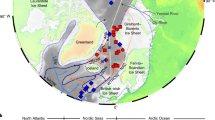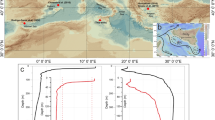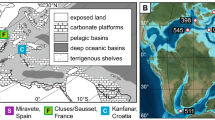Abstract
The hydrological balance of the Black Sea is governed by riverine input and by the exchange with the Mediterranean Sea through the shallow Bosporus Strait. These sources have distinctly different oxygen isotope (δ18O) signatures. Therefore, the δ18O of Black Sea water directly reflects the presence or absence of a connection with the Mediterranean Sea, as well as hydrological changes in the vast watersheds of the Black and Caspian seas1,2,3. However, the timing of late to middle Pleistocene water intrusions to the Black Sea is poorly constrained in sedimentary sequences4,5. Here we present a stacked speleothem δ18O record from Sofular Cave in northern Turkey that tracks the isotopic signature of Black Sea surface water, and thus allows a reconstruction of the precise timing of hydrological shifts of the Black Sea. Our record, which extends discontinuously over the last 670,000 years, suggests that the connection between the Black Sea and Mediterranean Sea has been open for a significant period at least twelve times since 670,000 yr ago, more often than previously suggested4,5. Distinct minima in the Sofular δ18O record indicate at least seven intervals when isotopically depleted freshwater from the Caspian Sea entered the Black Sea. Our data provide precisely dated evidence for a highly dynamic hydrological history of the Black Sea.
This is a preview of subscription content, access via your institution
Access options
Subscribe to this journal
Receive 12 print issues and online access
$259.00 per year
only $21.58 per issue
Buy this article
- Purchase on Springer Link
- Instant access to full article PDF
Prices may be subject to local taxes which are calculated during checkout



Similar content being viewed by others
References
Deuser, W. G. Late-Pleistocene and Holocene history of Black Sea as indicated by stable-isotope studies. J. Geophys. Res. 77, 1071–1077 (1972).
Bahr, A. et al. Abrupt changes of temperature and water chemistry in the late Pleistocene and early Holocene Black Sea. Geochem. Geophys. Geosyst. 9, Q01004 (2008).
Major, C. O. et al. The co-evolution of Black Sea level and composition through the last deglaciation and its paleoclimatic significance. Quat. Sci. Rev. 25, 2031–2047 (2006).
Zubakov, V. A. Climatostratigraphic scheme of the Black Sea Pleistocene and its correlation with the oxygen isotope scale and glacial events. Quat. Res. 29, 1–24 (1988).
Svitoch, A. A., Selivanov, A. O. & Yanina, T. A. Paleohydrology of the Black Sea Pleistocene basin. Wat. Resour. 27, 655–664 (2000).
Ryan, W. B. F. et al. An abrupt drowning of the Black Sea shelf. Mar. Geol. 138, 119–126 (1997).
Gökasan, E. et al. On the origin of the Bosphorus. Mar. Geol. 140, 183–199 (1997).
Chepalyga, A. L. The Black Sea Flood Question: Changes in Coastline, Climate and Human Settlement Ch. 6 (Springer, 2007).
Fleitmann, D. et al. Timing and climatic impact of Greenland interstadials recorded in stalagmites from northern Turkey. Geophys. Res. Lett. 36, L19707 (2009).
Bowen, G. J. & Revenaugh, J. Interpolating the isotopic composition of modern meteoric precipitation. Wat. Resour. Res. 39, 1299–1311 (2003).
Lachniet, M. S. Climatic and environmental controls on speleothem oxygen-isotope values. Quat. Sci. Rev. 28, 412–432 (2009).
von Grafenstein, U., Erlenkeuser, H., Brauer, A., Jouzel, J. & Johnsen, S. J. A mid-European decadal isotope-climate record from 15,500 to 5,000 years BP. Science 284, 1654–1657 (1999).
Bar-Matthews, M., Ayalon, A., Gilmour, M., Matthews, A. & Hawkesworth, C. J. Sea–land oxygen isotopic relationships from planktonic foraminifera and speleothems in the Eastern Mediterranean region and their implication for paleorainfall during interglacial intervals. Geochim. Cosmochim. Acta 67, 3181–3199 (2003).
Roberts, N. et al. Stable isotope records of Late Quaternary climate and hydrology from Mediterranean lakes: The ISOMED synthesis. Quat. Sci. Rev. 27, 2426–2441 (2008).
Swart, P. K. The oxygen and hydrogen isotopic composition of the Black-Sea. Deep-Sea Res. A 38, S761–S772 (1991).
Özsoy, E., Rank, D. & Salihoglu, I. Pycnocline and deep mixing in the Black Sea: Stable isotope and transient tracer measurements. Estuar. Coast. Shelf Sci. 54, 621–629 (2002).
Soulet, G. et al. Glacial hydrologic conditions in the Black Sea reconstructed using geochemical pore water profiles. Earth Planet. Sci. Lett. 296, 57–66 (2010).
Siddall, M. et al. Sea-level fluctuations during the last glacial cycle. Nature 423, 853–858 (2003).
Rohling, E. J. et al. Comparison between Holocene and Marine Isotope Stage-11 sea-level histories. Earth Planet. Sci. Lett. 291, 97–105 (2010).
Oktay, F. Y. et al. The effects of the North Anatolian Fault zone on the latest connection between Black Sea and Sea of Marmara. Mar. Geol. 190, 367–382 (2002).
Ferronsky, V. I. et al. Investigation of water-exchange processes in the Caspian Sea on the basis of isotopic and oceanographic data. Wat. Resour. 30, 15–28 (2003).
Yanko-Hombach, V., Gilbert, A. S. & Dolukhanov, P. Controversy over the great flood hypotheses in the Black Sea in light of geological, paleontological, and archaeological evidence. Quat. Int. 167, 91–113 (2007).
Sidorchuk, A. Y., Panin, A. V. & Borisova, O. K. Morphology of river channels and surface runoff in the Volga River basin (East European Plain) during the Late Glacial period. Geomorphology 113, 137–157 (2009).
Mangerud, J. et al. Ice-dammed lakes and rerouting of the drainage of northern Eurasia during the last Glaciation. Quat. Sci. Rev. 23, 1313–1332 (2004).
Svendsen, J. I. et al. Late quaternary ice sheet history of northern Eurasia. Quat. Sci. Rev. 23, 1229–1271 (2004).
Froehlich, K. Evaluating the water balance of inland seas using isotopic tracers: The Caspian Sea experience. Hydrol. Process. 14, 1371–1383 (2000).
Astakhov, V. Middle Pleistocene glaciations of the Russian north. Quat. Sci. Rev. 23, 1285–1311 (2004).
Colleoni, F., Krinner, G., Jakobsson, M., Peyaud, V. & Ritz, C. Influence of regional parameters on the surface mass balance of the Eurasian ice sheet during the peak Saalian (140 kya). Global Planet. Change 68, 132–148 (2009).
Bard, E. et al. Deglacial sea-level record from Tahiti corals and the timing of global meltwater discharge. Nature 382, 241–244 (1996).
Lisiecki, L. E. & Raymo, M. E. A Pliocene–Pleistocene stack of 57 globally distributed benthic δ18O records. Paleoceanography 20, PA1003 (2005).
Acknowledgements
Support of the Swiss National Science Foundation (grant PP002-110554/1 to D.F.), the US National Science Foundation (ESH 0502535 to R.L.E. and H.C.), the Gary Comer Science and Education Foundation (CP41 to R.L.E.) and Istanbul Technical University (grant ITU-BAP-332491 to O.T.) facilitated this work. We would like to thank P. C. Tzedakis and M. Siddall for providing their data and for helpful discussions.
Author information
Authors and Affiliations
Contributions
D.F. and O.T. initiated the project. S.B., A.Z., O.M.G. and D.F. performed the stable isotope analysis. H.C., S.B. and R.L.E. conducted the uranium-series analysis. S.B. and D.F. wrote the paper.
Corresponding authors
Ethics declarations
Competing interests
The authors declare no competing financial interests.
Supplementary information
Supplementary Information
Supplementary Information (PDF 1876 kb)
Rights and permissions
About this article
Cite this article
Badertscher, S., Fleitmann, D., Cheng, H. et al. Pleistocene water intrusions from the Mediterranean and Caspian seas into the Black Sea. Nature Geosci 4, 236–239 (2011). https://doi.org/10.1038/ngeo1106
Received:
Accepted:
Published:
Issue Date:
DOI: https://doi.org/10.1038/ngeo1106
This article is cited by
-
Dansgaard-Oeschger cycles of the penultimate and last glacial period recorded in stalagmites from Türkiye
Nature Communications (2024)
-
Freshwater influx to the Eastern Mediterranean Sea from the melting of the Fennoscandian ice sheet during the last deglaciation
Scientific Reports (2022)
-
Central Mediterranean rainfall varied with high northern latitude temperatures during the last deglaciation
Communications Earth & Environment (2022)
-
Black Sea hydroclimate and coupled hydrology was strongly controlled by high-latitude glacial climate dynamics
Communications Earth & Environment (2021)
-
Cosmogenic data about offset uplifted river terraces and erosion rates: implication regarding the central North Anatolian Fault and the Central Pontides
Mediterranean Geoscience Reviews (2021)



